
Ipomoea corymbosa is a species of morning glory, native throughout Latin America from Mexico as far south as Peru and widely naturalised elsewhere. Its common names include Christmasvine, Christmaspops, and snakeplant.
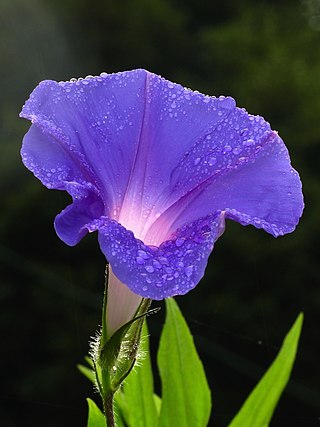
Morning glory is the common name for over 1,000 species of flowering plants in the family Convolvulaceae, whose current taxonomy and systematics are in flux. Morning glory species belong to many genera, some of which are:
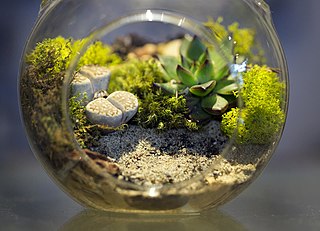
A vivarium is an area, usually enclosed, for keeping and raising animals or plants for observation or research. Water-based vivaria may have open tops providing they are not connected to other water bodies. An animal enclosure is considered a vivarium only if it provides quality of life through naturalistic components such as ample living space and natural decor that allow and encourage natural behaviours. Often, a portion of the ecosystem for a particular species is simulated on a smaller scale, with controls for environmental conditions such as temperature, humidity and light.

Anubias is a genus of aquatic and semi-aquatic flowering plants in the family Araceae, native to tropical central and western Africa. They primarily grow in rivers and streams, but can also be found in marshes. They are characterized by broad, thick, dark leaves that come in many different forms. The genus was revised in 1979 and since then its nomenclature has been stable. Species can be determined by using mostly characteristics of the inflorescence. Because of the often shady places where the plants grow, the genus was named after the Egyptian god Anubis, the god of the afterlife. The genus was first described in 1857 by Heinrich Wilhelm Schott, with A. afzelii as its type species.
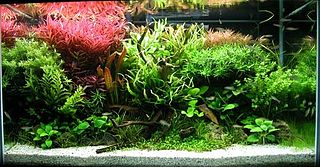
Aquascaping is the craft of arranging aquatic plants, as well as rocks, stones, cavework, or driftwood, in an aesthetically pleasing manner within an aquarium—in effect, gardening under water. Aquascape designs include a number of distinct styles, including the garden-like Dutch style and the Japanese-inspired nature style. Typically, an aquascape houses fish as well as plants, although it is possible to create an aquascape with plants only, or with rockwork or other hardscape and no plants.

Fishkeeping is a popular hobby, practiced by aquarists, concerned with keeping fish in a home aquarium or garden pond. There is also a piscicultural fishkeeping industry, serving as a branch of agriculture.

In biology, detritus is dead particulate organic material, as distinguished from dissolved organic material. Detritus typically includes the bodies or fragments of bodies of dead organisms, and fecal material. Detritus typically hosts communities of microorganisms that colonize and decompose it. In terrestrial ecosystems it is present as leaf litter and other organic matter that is intermixed with soil, which is denominated "soil organic matter". The detritus of aquatic ecosystems is organic material that is suspended in the water and accumulates in depositions on the floor of the body of water; when this floor is a seabed, such a deposition is denominated "marine snow".

Leptochilus pteropus, synonym Microsorum pteropus, commonly known as Java fern after the Indonesian island of Java, can be found in Malaysia, Thailand, Northeast India and some regions of China. It is a highly variable plant with several different geographic varieties that vary in leaf size and shape. Found in its natural habitat growing attached to roots and rocks, it can grow in both fully and partially submerged environs. The plant can propagate through small adventitious plants formed on older leaves, which attach themselves to hard substrates.

Hygrophila difformis, commonly known as water wisteria, is an aquatic plant in the acanthus family. It is found in marshy habitats on the Indian subcontinent in Bangladesh, Bhutan, India and Nepal. It grows to a height of 20 to 50 cm with a width of 15 to 25 cm.
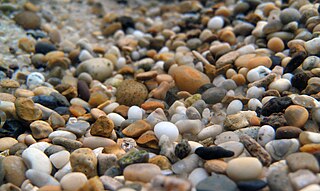
The substrate of an aquarium refers to the material used on the tank bottom. It can affect water chemistry, filtration, and the well-being of the aquarium's inhabitants, and is also an important part of the aquarium's aesthetic appeal. The appropriate substrate depends on the type of aquarium; the most important parameter is whether the aquarium contains fresh water or saltwater.
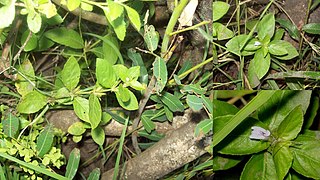
Hygrophila costata, with the common names glush weed, gulf swampweed, and yerba de hicotea, is an aquatic plant.

Limnophila sessiliflora, known as dwarf ambulia, ambulis, and Asian marshweed is a flowering plant in the family Plantaginaceae.

Hygrophila, commonly known as swampweeds, is a genus of flowering plants in the acanthus family, Acanthaceae. There are about 80 to 100 species, of which many are aquatic plants. The genus is distributed across the tropical and subtropical world. It is one of only two genera in its family that contains aquatic plants, the other being Justicia. The genus is treated in the tribe Hygrophileae, which is noted as being in need of revision at the genus level, meaning the current taxonomic boundaries of Hygrophila are likely to change in the future.

Hakea corymbosa, commonly known as the cauliflower hakea is a plant of the family Proteaceae which is endemic to the south-west of Western Australia. An attractive extremely prickly bush with sweetly scented yellowish flowers. The nectar rich blooms and dense form provides a good habitat for wildlife.

A freshwater aquarium is a receptacle that holds one or more freshwater aquatic organisms for decorative, pet-keeping, or research purposes. Modern aquariums are most often made from transparent glass or acrylic glass. Typical inhabitants include fish, plants, amphibians, and invertebrates, such as snails and crustaceans.

Hygrophila polysperma, commonly known as dwarf hygrophila, dwarf hygro, Miramar weed, Indian swampweed or Indian waterweed, is an aquatic plant in the family Acanthaceae. It is native to Bangladesh, India, China and Malaysia, and has also been introduced to the US states of Florida, Texas and possibly Virginia. It is listed on the Federal Noxious Weed List in the US and is illegal to import and sell in a number of states including Kansas and South Carolina.

An aquarium is a vivarium of any size having at least one transparent side in which aquatic plants or animals are kept and displayed. Fishkeepers use aquaria to keep fish, invertebrates, amphibians, aquatic reptiles, such as turtles, and aquatic plants. The term aquarium, coined by English naturalist Philip Henry Gosse, combines the Latin root aqua, meaning 'water', with the suffix -arium, meaning 'a place for relating to'.

Hygrophila auriculata is a herbaceous, medicinal plant in the acanthus family that grows in marshy places and is native to tropical Asia and Africa. In India it is commonly known as kokilaksha or gokulakanta, in Sri Lanka as neeramulli. In Kerala it is called vayalchulli (വയൽച്ചുളളി). In Tamil it is called Neermulli (நீர்முள்ளி).
Olearia hygrophila, commonly known as swamp daisy or water daisy, is a species of flowering plant in the family Asteraceae and is endemic to a restricted part of North Stradbroke Island in south-eastern Queensland. It is a shrub with slender stems, linear leaves and white and yellow, daisy-like inflorescences.

















